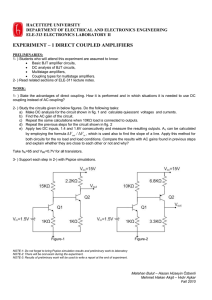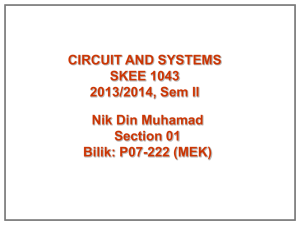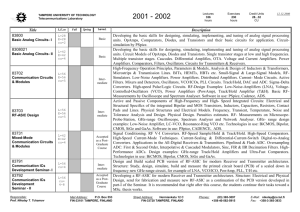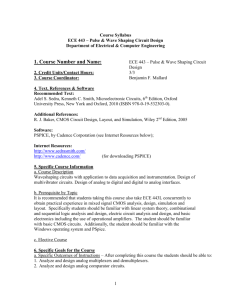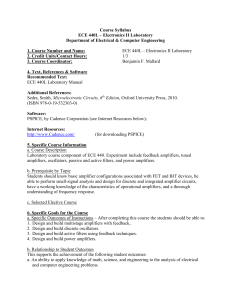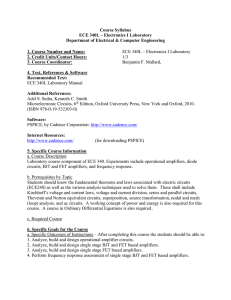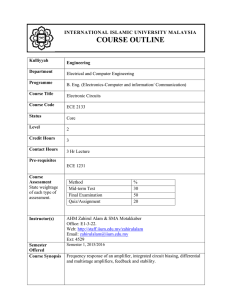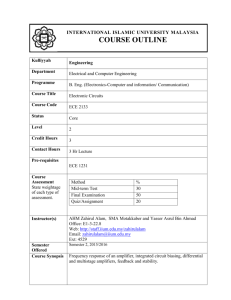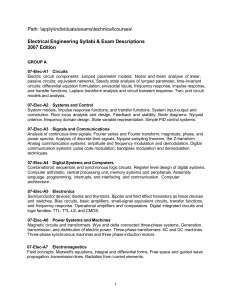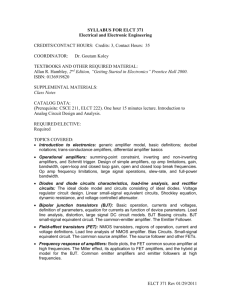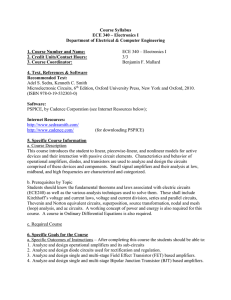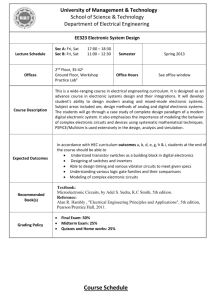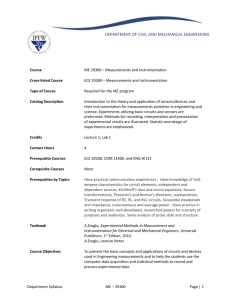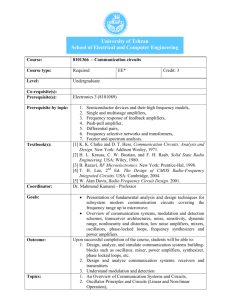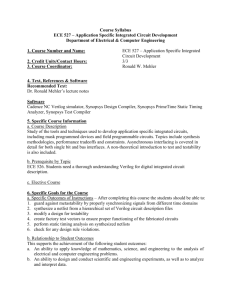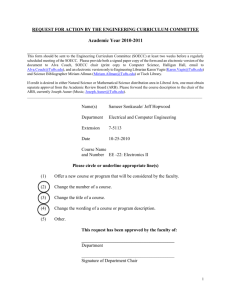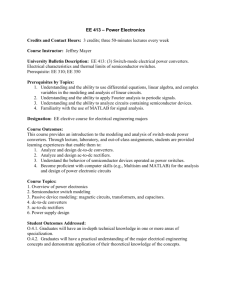ECE 443L ()
advertisement
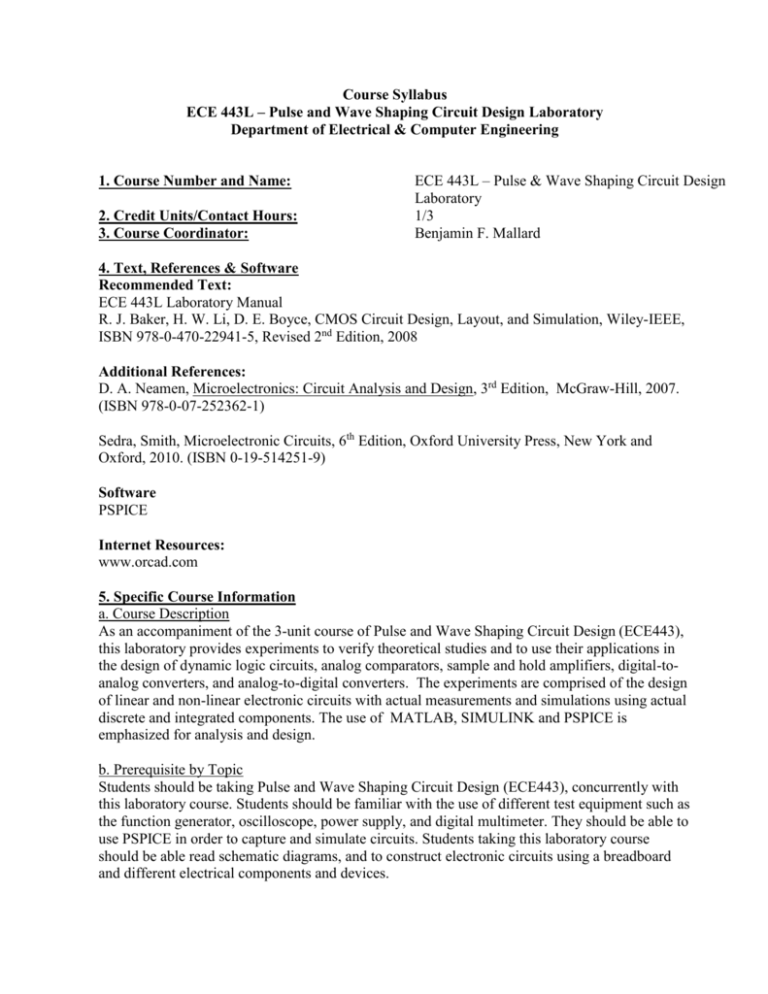
Course Syllabus ECE 443L – Pulse and Wave Shaping Circuit Design Laboratory Department of Electrical & Computer Engineering 1. Course Number and Name: 2. Credit Units/Contact Hours: 3. Course Coordinator: ECE 443L – Pulse & Wave Shaping Circuit Design Laboratory 1/3 Benjamin F. Mallard 4. Text, References & Software Recommended Text: ECE 443L Laboratory Manual R. J. Baker, H. W. Li, D. E. Boyce, CMOS Circuit Design, Layout, and Simulation, Wiley-IEEE, ISBN 978-0-470-22941-5, Revised 2nd Edition, 2008 Additional References: D. A. Neamen, Microelectronics: Circuit Analysis and Design, 3rd Edition, McGraw-Hill, 2007. (ISBN 978-0-07-252362-1) Sedra, Smith, Microelectronic Circuits, 6th Edition, Oxford University Press, New York and Oxford, 2010. (ISBN 0-19-514251-9) Software PSPICE Internet Resources: www.orcad.com 5. Specific Course Information a. Course Description As an accompaniment of the 3-unit course of Pulse and Wave Shaping Circuit Design (ECE443), this laboratory provides experiments to verify theoretical studies and to use their applications in the design of dynamic logic circuits, analog comparators, sample and hold amplifiers, digital-toanalog converters, and analog-to-digital converters. The experiments are comprised of the design of linear and non-linear electronic circuits with actual measurements and simulations using actual discrete and integrated components. The use of MATLAB, SIMULINK and PSPICE is emphasized for analysis and design. b. Prerequisite by Topic Students should be taking Pulse and Wave Shaping Circuit Design (ECE443), concurrently with this laboratory course. Students should be familiar with the use of different test equipment such as the function generator, oscilloscope, power supply, and digital multimeter. They should be able to use PSPICE in order to capture and simulate circuits. Students taking this laboratory course should be able read schematic diagrams, and to construct electronic circuits using a breadboard and different electrical components and devices. c. Elective Course 6. Specific Goals for the Course a. Specific Outcomes of Instructions – After completing this course the students should be able to: 1. Analyze and design multistage amplifiers with feedback. 2. Understand and use the concepts of stability in designing feedback amplifiers. 3. Analyze and design discrete and integrated oscillators. 4. Analyze and design active filters using feedback techniques. 5. Analyze and design power amplifiers b. Relationship to Student Outcomes This supports the achievement of the following student outcomes: a. An ability to apply knowledge of math, science, and engineering to the analysis of electrical and computer engineering problems. b. An ability to design and conduct scientific and engineering experiments, as well as to analyze and interpret data. c. An ability to design systems which include hardware and/or software components within realistic constraints such as cost, manufacturability, safety and environmental concerns. e. An ability to identify, formulate, and solve electrical and computer engineering problems. g. An ability to communicate effectively through written reports and oral presentations. oral presentation rubric. i. A recognition of the need for and an ability to engage in life-long learning. k. An ability to use modern engineering techniques for analysis and design. m. An ability to analyze and design complex devices and/or systems containing hardware and/or software components. n. Knowledge of math including differential equations, linear algebra, complex variables and discrete math. 7. Topics Covered/Course Outline 1. Dynamic CMOS Logic Circuits 2. Comparators 3. Latches and Flip-Flops 4. Sample and Hold Amplifiers 5. Digital-to-Analog Converters 6. Analog-to-Digital Converters Prepared by: Benjamin F. Mallard, Professor of Electrical and Computer Engineering, November 2011 Ali Amini, Professor of Electrical and Computer Engineering, March 2013
